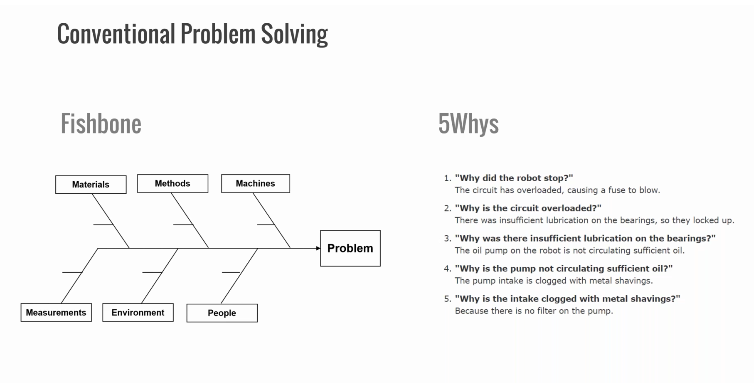Root Cause Analysis
In the terms of reliability, there are two types of RCA, Root Cause Symptom Analysis (RCSA) & Root Cause Failure Analysis (RCFA).
Root Cause Symptom Analysis
RCSA is a part of the CBM procedure. Whenever the trend of any parameter under condition monitoring, (like vibration, temperature, Ultrasound, oil Contamination, pressure, current) rises upwards, it indicates intrusion of some fault in the asset. After getting this early signal, RCSA is done.
The Techniques used to do RCSA may be Vibration Spectrum Analysis, Vibration Time Waveform Analysis, Vibration Phase analysis, vibration Probing Study, Vibration Octave Analysis, Vibration Bump test, Vibration Run Up – Cost Down Analysis, Vibration Orbit Analysis, Ultrasound Analysis, Thermography, Oil Analysis, etc. The selection of correct technique depends on the type of fault.
After concluding the root cause, CAPA will be taken to restore the health of the asset back to normal.

Root Cause Failure analysis
RCFA – Root Cause Failure Analysis is a root cause analysis done after the functional failure of the asset. Here the asset is already stopped working and not in service. RCFA is done to know why the asset failed, and further to ensure that any negative deviation in performance for any asset or system WILL NOT HAPPEN AGAIN.
Following steps are taken to do RCFA,
- Collect the data of parameters like vibration, ultrasound, temperature (thermal image), current, voltage, pressure etc recorded before failure.
- Checking the deviation in the data of any parameter with recorded base data of the same asset. We may get root cause at this step itself if we have generated base data for that asset.
- Keep all the circumstantial evidence secured & untouched for detailed inspection. Before cleaning the evidence for any reason do not forget to take a close photograph of it. We need those for detailed inspection to investigate the failure.
- Brainstorm & List the possible Causes. Draw a Fishbone Diagram ( Cause & Effect Diagram) by considering each probable cause might have contributed to the failure.
- Take 5 WHY steps on each cause of the fishbone diagram..
- Repeat asking why for every cause.
- Compare the answers of each cause with the evidence & available Data.
- Derive Root Cause/Causes

